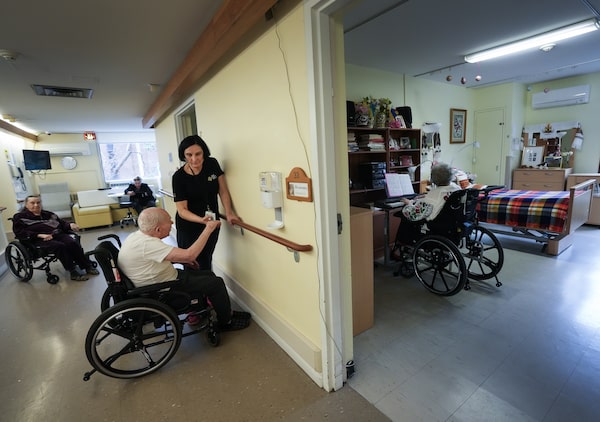
A health-care worker helps an elderly man do strength exercises at the Ivan Franko Long-term Care Home, a Ukrainian cultural home in Toronto, on April 3.Nathan Denette/The Canadian Press
In an Italian long-term care home in Toronto, about three new non-Italian residents are admitted each month due to government changes to priority rules, leaving them confused and isolated in a setting where they do not speak the language.
Villa Colombo’s programming is done in Italian, and many of the new residents don’t speak Italian or even English, said executive director Lisa Alcia.
But they are being admitted because of how hospital patients who can be discharged but can’t be cared for at home are now prioritized.
“I feel for these residents,” Alcia said.
“They’ve been in a hospital, now they’re forced into an environment where all the residents around them speak Italian, and they don’t. If you’ve got slight dementia, that triggers a whole lot of negative behaviours because you’re culturally isolated.”
It’s a situation playing out in the several dozen cultural long-term care homes across the province, which cater to seniors from Korean, Jewish, francophone and many other communities, according to the association representing non-profit homes.
A law known as Bill 7 enacted in 2022 has garnered much criticism for allowing people to be placed in a long-term care home not of their choosing, but AdvantAge Ontario CEO Lisa Levin said the law has had other consequences as well.
“The priority has gone to … people coming out of the hospitals and there’s a very rigid bureaucracy behind these admissions,” she said.
“So the first person on the list could be someone who doesn’t have a preference for a cultural home and the second person on the list could be someone who wants to get into a Finnish home, because they’re Finnish. The first available space may be in a Finnish home. It will go to the other person who was No. 1 on the list.”
Bill 7 is aimed at moving so-called alternate level of care patients – who can be discharged from hospital but need a long-term care bed and don’t yet have one – in order to free up hospital space.
If there are no spaces available in long-term care homes a patient has put on their preferred list, they can instead be transferred to a home up to 70 kilometres away – or 150 kilometres if they are in northern Ontario – selected by a placement co-ordinator at the hospital.
Hospitals are required to charge patients $400 a day if they refuse the transfer.
Levin, of AdvantAge Ontario, said it seems like the impact on cultural home admissions was an unintended consequence of Bill 7 and she has had “encouraging” conversations with Minister Stan Cho about how to address it.
Cho, who took over as long-term care minister in a cabinet shuffle in September, said that as a Korean Canadian, issues around cultural homes are hugely important to him.
“We are looking actively at a solution,” he said.
“We think there’s some good traction with the homes as well as organizations like AdvantAge to find that. You don’t want unintended consequences to have further unintended consequences, especially when we have an overall capacity issue.”
At the Ivan Franko Long-Term Care Home, a Ukrainian cultural home in Toronto, occupancy is at about 25 per cent non-Ukrainian residents, up from between eight and 10 per cent pre-pandemic, said CEO Olya Vovnysh.
“We go far and beyond … we do anything possible (that) we can do for them to provide best care environment,” she said.
“I would say that those residents, they face challenges in adapting to our culture, traditions, cuisine and our home.”
When it comes to cuisine, for example, the Ukrainian menu features potatoes prominently, but people from some other cultures prefer rice or pasta, leaving the dietary staff preparing extra meals, she said.
Ukrainians celebrate Orthodox Easter, which this year falls on May 5, but the home has now started having two Easter celebrations in order to accommodate residents who celebrated it this year at the end of March, Vovnysh said.
Staff members also try to greet all of the residents in their own language and ask them basic questions about their needs, for example asking if they would like a drink of water, she said. It is becoming more challenging with people in the home from Canadian, Jamaican, Polish, Italian, Romanian, Serbian, French, Cuban, Spanish, Greek, Portuguese, Croatian, Russian and German backgrounds.
Vovnysh said she doesn’t want to criticize the government, which she said has provided a lot of supports, but she hopes the admissions process can be improved.
“It’s not about legislation,” she said.
“It’s about people and their choices … Not every Canadian wants to be in a Canadian home. Not every representative of a specific ethnic group wants to be at an ethnic group home. There are choices and we need to enable that choice and understand their needs.”